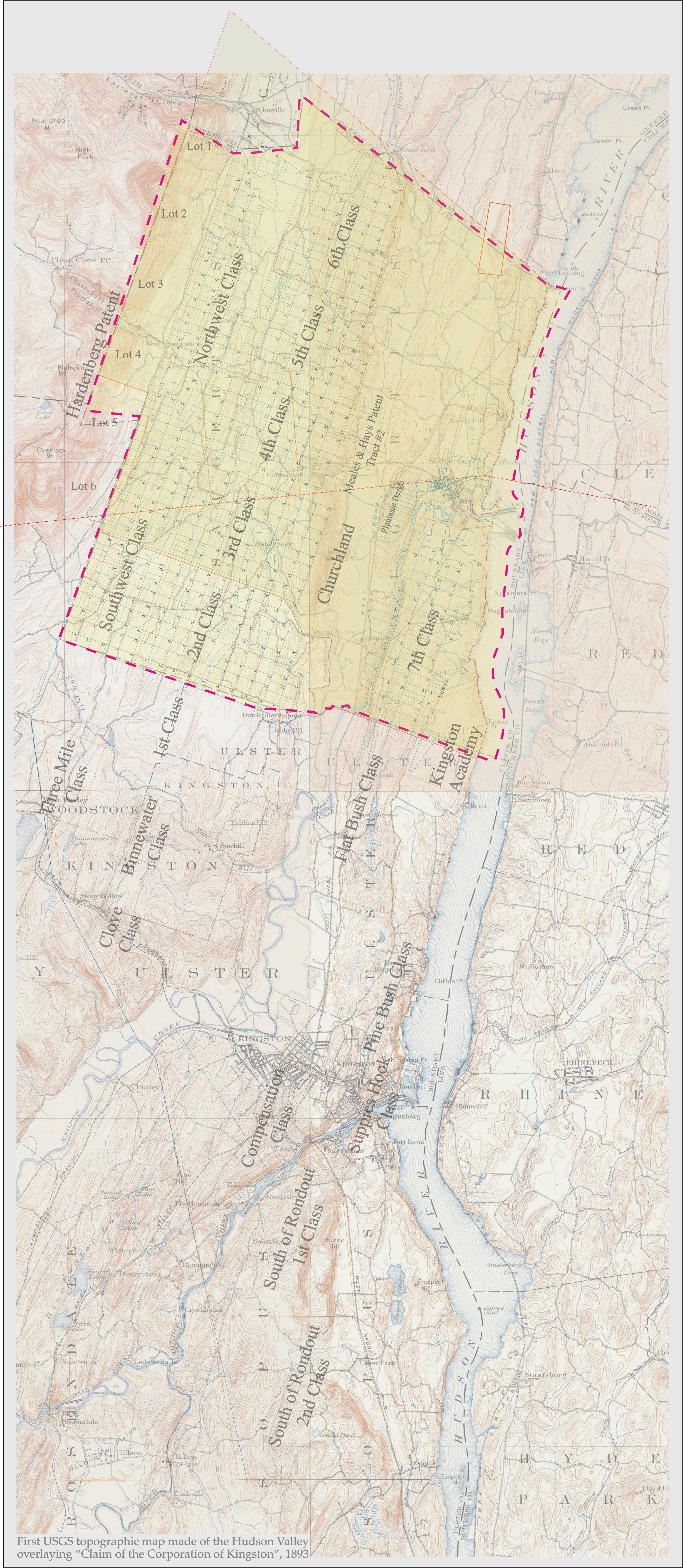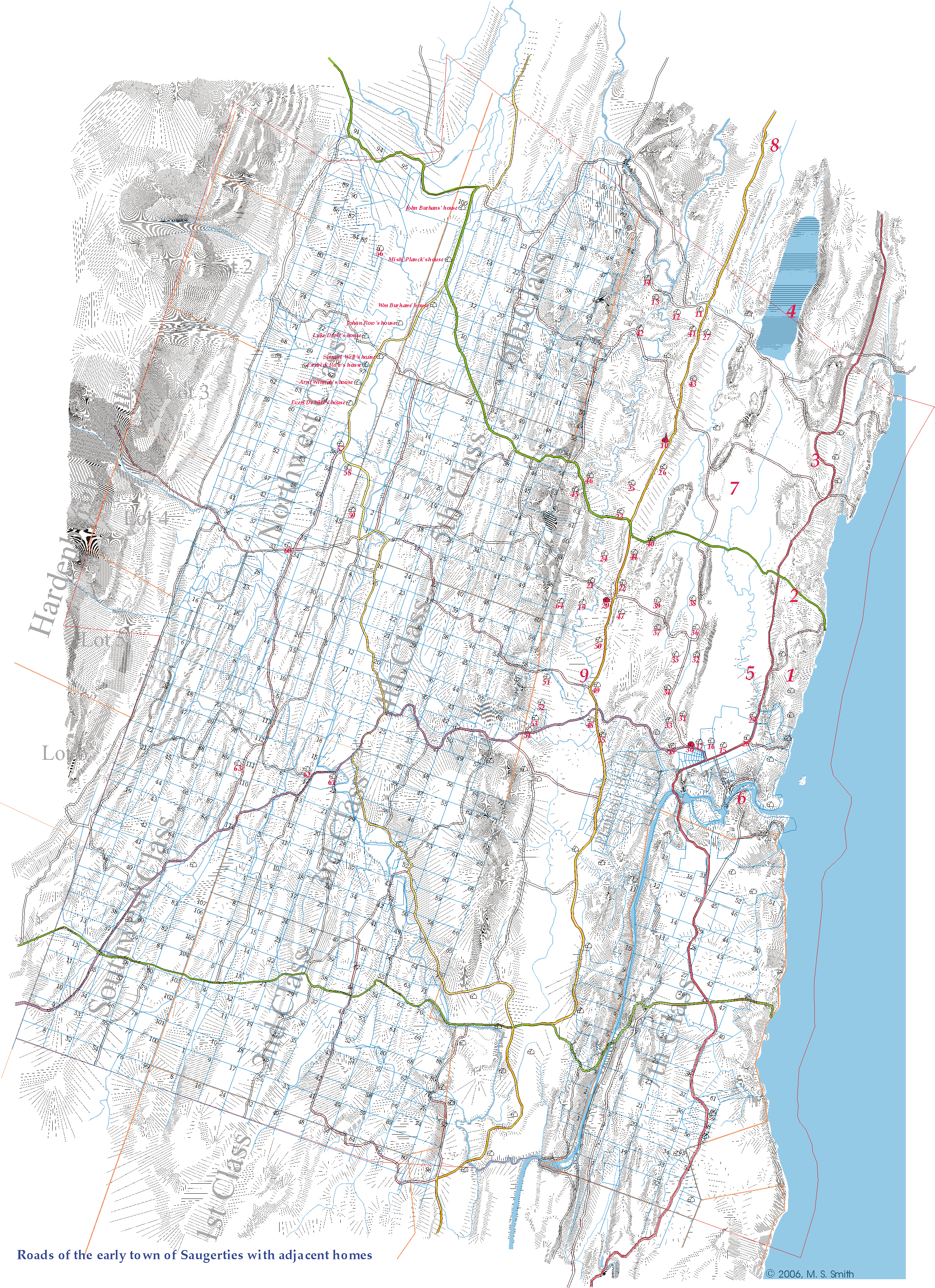

|
November 3, 1825 a flotilla of steamboats celebrating the opening of the Erie Canal passed the land that would, within a year, contain Barclay’s dam and mill pond on the Esopus Creek and his mills within sight of the Hudson. That same fall surveying had begun on the Delaware and Hudson Canal that would bring coal from the mines of Pennsylvania to the Hudson at the Rondout Creek. For nearly 200 years the tide waters of the Hudson River provided a natural and effortless link between its shoreline inhabitants and the world at large. The movement of its waters needed no human intervention. With the Erie Canal water transportation took on an engineering focus and the power of water in general began to drive the broader imagination of the time. Water power ran many mills over the past century at the two falls where the Esopus Creek reached tide water at Saugerties. Each fall had a 15 to 20 foot drop supplying force to their water wheels but high banks, solid rock cliffs and three right angle turns limited the number of natural mill sites there. On the west bank, below the last fall before tide water, where a hundred years before John Persen operated one of the first mills, Robert L. had invested $10,000 in a new mill building. At this fall Henry Barclay constructed a 30 foot high dam that loomed over this 3 story mill building and through the high cliff on the opposite east bank he cut a deep channel in the solid rock. This channel directed the enormous pressure of the water the dam backed up over the second fall and up the long gorge to its south into a system of mill races to support the more extensive acreage available for mill sites on the east side of the Esopus. For the time the engineering that controlled the waters of the great Esopus through these serpentine channels was an incredible feat. It was equal to the present concept of the Power Plant. Power was leased to the mill sites based on the potential flow through pipes and smaller distribution channels. The volume of water behind the dam continuously replenished by the Esopus watershed made this resource at Saugerties the most valuable in the state, and perhaps in the world when it was built. While the water systems were being completed Henry Barclay was building two factories. A mill for rolling and slitting iron was first put into production and immediately sold to have the capability of “100 tons of Iron from Pigs by Puddling per week“ added to it. The sale amount was then used to purchase and install equipment for machine-made paper into the second plant. Before the close of the decade two smaller factories for making axes and barrel hoops were operating next to the paper mill. The two main industries of Saugerties, making purified iron and machine-made paper, both anticipated directions and manufacturing needs that the next decade would bring. Iron making would explode in demand with the coming of the railroads. The economy that the westward expansion generated stressed the supply of paper required by the increase in transactions. It was not only for innovations in the application of waterpower that Saugerties would be a showcase but also the concept of being ahead of the demand curve. It was also ahead of the curve in the social changes that were taking place in the Hudson Valley. Both the Erie and the D&H canals provided a focus on the Hudson River that would see the population of New York City balloon by the end of the decade. Within a year afer the opening of the Erie Canal 40 barges a day would carry thousands of passengers and tens of thousands of bushels of grain per year from western New York and Ohio farms to the port of New York past Saugerties. The farms of the Hudson Valley and especially the large tenant farmlands of the Livingstons had provided the flour, meat and firewood that sustained New York City’s population since the end of the Revolution. By the close of the 1820’s competitive prices bypassed them for this market. The growing grain belt of the mid-west and its meat packing houses were supplying an endless flow of product along the Erie Canal and D&H Canal coal was revolutionized heating and cooking in the City. The change brought about by the canal boom was nowhere more apparent than at Glasco. It brought an end to the great activity there that, for a short time, made it a major port on the Hudson. For a decade cargos that came down the Ulster and Delaware turnpike by team lined the long parallel streets on its heights awaiting the sloops that would take it down to the New York markets. The great bay between Glasco and Tivoli allowed for a high level of river traffic in the day of sail and Glasco was primed to have the commercial advantage of the best land and water assets. The U&D was for this period the shortest link between the wheat belt of central New York and the Hudson and since the Esopus had always been the center of wheat trade Glasco was the center of its interest. Now, with shipping dropped from $100 a ton on the turnpike to under nine on the canal, hundreds of teamsters, carters and market sloop captains, professions dominated by the Dutch since early colonial days, were put out of work. With the loss of the wheat trade Glasco declined right along with the prestige and fortunes that both the old Esopus and the Manor families enjoyed from their long hold on the agrarian economy of the Hudson Valley. With this decline the legendary power center of Esopus and its Kingston Commons fell into obscurity to be nearly erased from memory within a generation. A new standard of wealth was to take hold on the West bank of the Hudson. This new wealth was still based on the land but on land that had been of no special importance to these early agrarian families. It was from what they regarded as worthless barrier palisades in South Kingston that a cement industry would grow. It was from the impassible high woods ledges they found so annoying in the Kingston Commons that there would blossom the bluestone industry. And from the bluffs along the river where the soil clung to their plows like lard would come the material for the brick industry. This same time brought an enormous shift in the basic levels of society. The actual planting and herding activities had long been carried out by the slaves of the large landholders or the tenants of the large manors. With the gradual emancipation of slaves enacted in 1799 finally removing all slavery in the state by 1827 and other changes in the state constitution in 1847 recognizing life tenancies in the manors as deeds in actuality, the basic systems of labor that made large land holdings profitable no longer existed. With the subsequent breakup of the agrarian dynasties over the mid-decades of the 19th century the Hudson Valley would begin to look toward other ways to grow its economy. The rivals for centers of the new economy of the old Esopus and Catskill Mountain regions were the ports of Rondout with the D&H canal terminals and the quarrying of the Vlightberg for its limestone to make cement, and the port of Saugerties with its iron and papermaking industries and the quarrying of its bluestone ledges for the sidewalk slabs of the growing metropolises of the Atlantic coast. The workers that this new economy attracted to Rondout and Saugerties were the Irish. During the short period between the founding of the Town of Saugerties and the establishing of the Villages of Rondout and Saugerties the freed slaves of the early Dutch families nearly all left to live in New York City and the influx of Irish immigrants into the City came upriver to fill the new limestone and bluestone quarrying jobs here. Like the workers they replaced, these new residents owned no land. But there were other Irish emigrants that came before them to work on the Erie and D&H canal, and that were brought in for the new industries of Saugerties. By the late 1830’s an Irish culture was present to welcome them, help them to settle and see that they had access to ownership of the many small farmland plots being parceled off by the earlier Dutch and Palatine landholders. In the 1840’s as the demand for bluestone grew scores of shanty towns sprung up as quarrying spread to every outcropping between Russell’s Clove in Saugerties and the heights of Mead Mountain in Woodstock. Nearly every one of these quarry sites was purchased through loans from Jeremiah Russell, every slab of Bluestone quarried from these lands went to market by way of Jeremiah Russell’s Saugerties and Woodstock Turnpike and nearly every cent paid for the slab at the dock was spent at a Russell store. |
By the 1840’s the Russell family was establishing its forth generation of influence in the Saugerties community. The founder, John Ludwig Roesle, arrived before the Revolution and married into the forth generation Palatine Fiero family. By 1833 Jeremiah, his youngest son, had amassed a fortune as a merchant and was already passing this activity on to William F., a third generation Russell, then only 21. From 1828 forward Jeremiah Russell engaged himself increasingly in the field of finance and related commercial development. This was a time known for politicization of banking and one of the reasons Saugerties was able to grow independently was because of the private banking services that Jeremiah Russell provided. His speculative insights on the value of land accessed by the Saugerties and Woodstock Turnpike caused him to be the largest holder of mortgages in the town. Over a period of three decades the growth of the town can be traced in the hundreds of deeds through which Jeremiah Russell moved subsistence farm families into hamlet and village residences opening their lands to quarrying, re-selling their land to new families engaged in this livelihood. As this happened hamlets grew becoming a focus of small blacksmith, wheelwright and carpentry businesses built on the skills of the earlier farmers as they were directed toward new livelihoods supplying services to those working the quarries. Jeremiah Russell’s profits from his land ventures were used to support their banking needs and also those of the larger industries and businesses of Saugerties Village. By the end of the 19th century nearly three generations of Saugerties’ inhabitants had lived knowing no other system than this locally interactive economy. The tides of social change that accompanied the industrialization period of the 1830’s and 40’s profoundly effected the native culture of Saugerties. Up until this time the predominant language was Dutch. It was the language of the farm worker, the teamster, the boatman. When the many slaves of the mid-Hudson Dutch were freed in 1827 they went to New York City mainly because they knew only Dutch and that was still the language of the carters and dock workers and the boatmen there. With the importation of workers for the mills and the opening of the quarries the predominant language of Saugerties had become almost overnight English. Native Dutch-speaking Jeremiah Russell had an English-speaking wife. By 1833 he had transferred all his merchant activities to his son whose wife and brother-in-law partner hailed from Connecticut. Their newly re-formed merchant business engaged in the sale of bluestone to the docks of Manhattan on sloops captained by the Dutch families of Saugerties. By the 1850’s the forth generation, the grandchildren of Jeremiah Russell, were marrying into the oldest Dutch families of the town, the Russell wealth helping to reestablish the influence of the threatened Dutch culture. In 1855 the name of the village of Ulster was changed to Saugerties as an expression of a desire to preserve this association with a pre-industrial Dutch heritage. In the 1880 History of Ulster County a grandchild of Jeremiah Russell, Frederick T. Russell, is heralded as the current exponent of Dutch culture having married Julia R. Mynderse and occupying the ancestral John Persen 1712 stone house on the river in the Village of Saugerties. The influence of the landed Dutch in Saugerties stayed apace with the new industrial-based wealth simply because the value of their land increased with the demand of its output. The farms of Saugerties fed the exponential increase of its non-farm population growth. In the post-Civil War census Saugerties farms, still owned at the time by the original Dutch families, were valued far higher and had higher output than any other farms in Ulster County and Saugerties had the highest population of all Ulster County towns. An enclave of “Yankee” culture had established itself in Malden by 1812 and was gaining wealth and influence in the tanning trade by the 1820’s. Asa Bigelow from Connecticut had formed a merchant business and incorporated the village of Bristol there and soon his wife’s family, the Ishams, followed. After that the families their children had married into moved in and by the 1830’s their combined numbers rivaled that of the earlier Dutch that surrounded them. Connections with the Yankee families that owned the large tanneries to the west through their Malden Turnpike expanded their influence further into these mountain communities. Asa Bigelow had purchased the DeWolffen patent and the adjacent VanSteenberg farm, a combined 500 acres of river front land hugged by the deep channel of the Hudson, making his improvements at Malden the most accessible for shipping in the area. His stores and those of the Ishams held a dominant position over all the trade of Saugerties because of this access. The first bluestone quarried by fellow Yankee Silas Brainard was shipped from these wharves and this soon saw a multitude of new land routs destined for Malden line the countryside. These early bluestone sales were direct to dealers that had stone yards up-river at Coxsackie. At the same time the early village records of Ulster (Saugerties) show an increase in its awareness of the infant bluestone trade. It was closer to the quarries and was beginning to show this off with its extensive sidewalks and curbed streets. The first location for these pedestrian improvements was at Jeremiah Russell’s store, before 1831, and had spread from there up Market Street, down Main Street and along Partition Street by 1833. The large population of Ulster, its growing commercial presence and its frequent visitors attracted by the manufacturers allowed it a strong association with bluestone through this display. By 1837 William F. Russell had focused his father’s business toward the direct purchase, sale and transport of bluestone and in 1846 Jeremiah Russell purchased the Silas Brainard quarries and other lands north and south of this original site. Quarrymen were not hired to work these sites. The land was leased to them and they operated the quarries as partnerships or families. It was generally Irish hard rock workers from the canals experienced in cutting and finishing the stone of the dikes, dams and locks that came to the quarries. They not only extracted the stone but also finished it to marketable shapes and transported it to the dealer ready for the sidewalk. They were each their own craftsman and entrepreneur. The Irish were attracted by the availability of land they could purchase. A vast amount of land had become available after the death in 1846 of Robert L. Livingston when his two sons and heirs, Eugene and Montgomery Livingston, sold all the leased farmsteads they owned to their tenants. This represented all of the lands of the Woodstock Valley between Saugerties and Shandaken and the mountainsides that lined it. To these mountainsides flocked Irish quarrymen where they could purchase speculative quarry sites from the former Livingston tenants in their uncultivatable upland acres. Jeremiah Russell carried hundreds of mortgages on these sites and they paid off many fold as the bluestone of Woodstock made the long trip over his Saugerties and Woodstock Turnpike to his docks on the Hudson. Just as Jeremiah Russell developed quarry sites along his turnpike the Bigelows similarly were supportive of quarrying along their Malden Turnpike at what would become Quarryville and at sites up the road’s mountain route in the Kaaterskill Clove. By mid-century these two turnpikes had become among the most active thoroughfares in the state carrying an unending flow of bluestone from the quarries to tidewater. One eight-ton wagon at a time multiplied by hundreds, day after day, moved the hillsides of Saugerties to far off cities as hundreds-of-thousands of flat, 2-inch thick slabs to pave their miles and miles of sidewalks. Most of the landscape that would have been familiar to its inhabitants when Saugerties was born in 1811 was completely changed by the time Jeremiah Russell died in 1867. Hills were removed, ledges were flattened to become pasture and passages were opened between valleys. This, as it would turn out, would be only the beginning. Another half century of quarrying was yet to come punctuated by ever increasing output until hardly a spot between upland Saugerties and the lower fringes of the Catskill Escarpment would be unscarred by an open quarry. But bluestone brought continuous economic benefits to Saugerties over the first century of its life and this added a stable population base to its countryside, hamlets and village and indirectly also to its national exposure as both Jeremiah Russell and his son William were elected to Congress and the son of Asa Bigelow, John, became ambassador to France under President Lincoln. |
|
|
Saugerties as the Showpiece of a New Age; The mid-Hudson follows Saugerties; Saugerties Integrates Old and New; and, Saugerties’ Landscape Begins to Change
